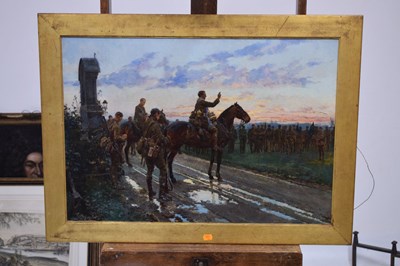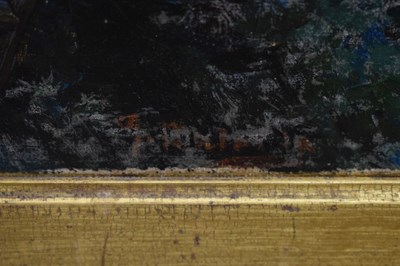7th Dec, 2023 10:30
Winter Specialist Sale
ARR Irish and Great War Interest - Fortunino Matania (1881-1963) - Oil on canvas - The Last General Absolution of the Munsters
Irish and Great War Interest - Fortunino Matania (1881-1963) - Oil on canvas - The Last General Absolution of the Munsters at Rue du Bois, signed in red lower left, 52.5cm x 75.5cm, framed
Fortunino Matania, (1881-1963) was born in Naples and was a well-known artist and illustrator in Italy, before moving to London in 1902. He worked for the illustrated weekly newspaper 'The Sphere', and became famous for depicting the sinking of The Titanic in 1912. He was an official war artist in the first World War and his graphic illustrations of trench warfare were highly renowned.
A description of the gestation of the original 1915 painting by Matania in the Irish times can be found here:
https://www.irishtimes.com/news/politics/mystery-surrounds-location-of-haunting-image-of-irish-soldiers-in-first-world-war-1.1886612
On the 8 May 1915 the 2nd Battalion, Royal Munster Fusiliers were making their way up the Rue du Bois to the front lines to take part in the Battle of Aubers Ridge that was to take place the following morning. Before reaching the front line the unit chaplain, Fr. Francis Gleeson, administered General Absolution to the Munsters. The men then sang the hymns 'Te Deum' and 'Hail Glorious St Patrick'.
A biography of Father Gleeson (depicted on horseback with arm raised in absolution) can be found here:
https://en.wikipedia.org/wiki/Francis_Gleeson_(priest)
Fortunino Matania was not present at the scene, but based his painting on a written account by Lieut. Col Rickard’s widow, Jessie, who is believed to have commissioned the painting in memory of her husband. His painting first appeared as a print in the Sphere magazine, and it is said that copies were displayed in many houses throughout Munster. It is believed that the original work may have been destroyed in the Second World War.
In 1919, Alfred Robinson of Backwell House, commissioned Matania to paint the present copy of his original, in order to celebrate the return from the War of his son Esmond, who had served in the Royal Field Artillery and won an MC and Bar before his 21st birthday. The painting was left by Esmond Robinson to his nephew, Charles Clarke, and on his death it became the property of his wife, the current owner.
Literature: See Gosling, Lucinda, ‘Goodbye Old Man: Matania's Vision of the First World War’, The History Press, 2014.
Sold for £21,000
Irish and Great War Interest - Fortunino Matania (1881-1963) - Oil on canvas - The Last General Absolution of the Munsters at Rue du Bois, signed in red lower left, 52.5cm x 75.5cm, framed
Fortunino Matania, (1881-1963) was born in Naples and was a well-known artist and illustrator in Italy, before moving to London in 1902. He worked for the illustrated weekly newspaper 'The Sphere', and became famous for depicting the sinking of The Titanic in 1912. He was an official war artist in the first World War and his graphic illustrations of trench warfare were highly renowned.
A description of the gestation of the original 1915 painting by Matania in the Irish times can be found here:
https://www.irishtimes.com/news/politics/mystery-surrounds-location-of-haunting-image-of-irish-soldiers-in-first-world-war-1.1886612
On the 8 May 1915 the 2nd Battalion, Royal Munster Fusiliers were making their way up the Rue du Bois to the front lines to take part in the Battle of Aubers Ridge that was to take place the following morning. Before reaching the front line the unit chaplain, Fr. Francis Gleeson, administered General Absolution to the Munsters. The men then sang the hymns 'Te Deum' and 'Hail Glorious St Patrick'.
A biography of Father Gleeson (depicted on horseback with arm raised in absolution) can be found here:
https://en.wikipedia.org/wiki/Francis_Gleeson_(priest)
Fortunino Matania was not present at the scene, but based his painting on a written account by Lieut. Col Rickard’s widow, Jessie, who is believed to have commissioned the painting in memory of her husband. His painting first appeared as a print in the Sphere magazine, and it is said that copies were displayed in many houses throughout Munster. It is believed that the original work may have been destroyed in the Second World War.
In 1919, Alfred Robinson of Backwell House, commissioned Matania to paint the present copy of his original, in order to celebrate the return from the War of his son Esmond, who had served in the Royal Field Artillery and won an MC and Bar before his 21st birthday. The painting was left by Esmond Robinson to his nephew, Charles Clarke, and on his death it became the property of his wife, the current owner.
Literature: See Gosling, Lucinda, ‘Goodbye Old Man: Matania's Vision of the First World War’, The History Press, 2014.
Auction: Winter Specialist Sale, 7th Dec, 2023
Our Winter Specialist Sale of Fine Furniture, Modern Design, Paintings, Prints, Silver, Jewellery, Watches, Ceramics, Glassware, Collector Items, Wines, and Spirits.
Viewing
Tuesday 5th December 10am - 5pm
Wednesday 6th December 10am - 5pm
Morning of Sale 9am - 10.30am


















